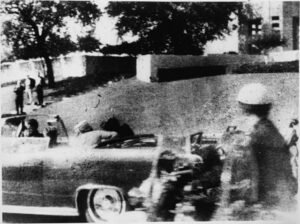10.1 Conditional Proof
The rule of conditional proof allows us to prove that a conditional claim is true, by proving that the consequent follows when we assume the antecedent. It is also known as “conditional introduction”.
Table of Contents
10.1.1 Provisional Assumptions

If a second gunman assassinated JFK, then he was on the grassy knoll.
For the Sake of Argument
In everyday reasoning, we make assumptions ‘for the sake of argument’, to see what would follow. For example, assume that the assassination of President John F. Kennedy involved a second gunman in addition to Lee Harvey Oswald, some shadowy figure hiding on the grassy knoll, as many conspiracy theorists believe. What would follow from that assumption? Well, one thing that would follow is that more than one person was involved. So, while we don’t know that there was a second gunman, we do know that if there was a second gunman, then more than one person was involved.
In propositional logic, we do the same thing. We make a “temporary” or “provisional” assumption, even if we don’t believe the assumption is true, in order to see what would follow if that assumption were true. For example, suppose that P & Q were true. We would know, by the rule of &E, that P must therefore be true. So, we know that if P & Q, then P. We can write this as a conditional: (P & Q) => P. We know that this conditional is true, even if we don’t know what P or Q stand for, or whether or not P is true, because we know that P would follow from P & Q by a valid rule of inference.
Tracking Assumptions
It is important to keep provisional assumptions separate from the rest of a proof, to make sure we don’t contaminate what we know with something we are merely assuming. So, to track assumptions, we use what are sometimes called “fitch bars”, “scope lines”, or “assumption lines” to keep track of them. We underline the provisional assumption and putting the words (assume) in parentheses, and then draw a straight line ( | ) to the left of every statement we rely on that assumption for to indicate that it is within the scope of that assumption. By “within the scope” of that assumption, we mean statements which hold true given that assumption, as opposed to those which hold true independently of that assumption. For instance, “JFK was assassinated” holds true independently of the assumption that conspiracy theorists are correct, but “Lee Harvey Oswald was not a lone gunman” only holds true given the assumption that conspiracy theorists are right. Here is what assumption lines look like:
Let:
C = Conspiracy theorists are right
S = There was a second gunman
O = Oswald was a lone gunman
1. C => S
2. S => ~O
3. | C (assume)
4. | S (1, 3 MP)
5. | ~O (2, 4 MP)
The line ( | ) to the left of ~O on line 5 indicates that ~O holds only within the scope of the assumption on line 3 that C is true. Line 5 is not proof that Oswald was not a lone gunman. Rather, it is a proof that if C were true, then ~O is true. That proof holds true independent of our assumption, so we can write it without the assumption line on line 6:
1. C => S
2. S => ~O
3. | C (assume)
4. | S (1, 3 MP)
5. | ~O (2, 4 MP)
6. C => ~O (3-5)
No Going Back
Once we’ve left the scope of an assumption line, we have “discharged” the assumption. That means we go back and can’t pull from anything within the scope of an assumption line. For example, line 7 below would be invalid:
1. C => S
2. S => ~O
3. | C (assume)
4. | S (1, 3 MP)
5. | ~O (2, 4 MP)
6. C => ~O (3-5)
7. (C => ~O) & S (4, 6 &I)
We can’t use S from line 4, because line 4 is marked by an assumption line, meaning that line 4 is within the scope of the assumption of C on line 3, but line 7 is not within the scope of that assumption. The assumption of C has been ‘discharged’, so everything within the scope of that assumption is now off limits: there is no going back.
So long as we stay within the scope of the assumption line, we can apply any other rules of inference we like:
1. C => S
2. S => ~O
3. | C (assume)
4. | S (1, 3 MP)
5. | ~O (2, 4 MP)
6. | S & ~O (4, 5 &I)
7. | (S & ~O) v B (7 vI)
Lines 6 and 7 above are valid, because the assumption line | is written next to both. There are only a few rules, however, which allow us to discharge a provisional assumption: that is, which allow us to take something that is within the scope of an assumption, and infer something from it that is not within the scope of an assumption. Again, the following would be invalid:
1. C => S
2. S => ~O
3. | C (assume)
4. | S (1, 3 MP)
5. | ~O (2, 4 MP)
6. S & ~O (!!INVALID!!)
We will study these three rules which do allow us to discharge an assumption within this module: conditional proof, indirect proof, and disjunction elimination. We’ll start with the rule we’ve already seen in practice, conditional proof (abbreviated CP):
1. C => S
2. S => ~O
3. | C (assume)
4. | S (1, 3 MP)
5. | ~O (2, 4 MP)
6. C => ~O (3-5 CP)
10.1.2 Method of Conditional Proof

Hypothetically, if humans were to land on Mars, then it would follow that somebody landed on Mars.
Conditional Proof (CP)
The rule of conditional proof allows us to prove that a conditional claim is true, by proving that the consequent follows when we assume the antecedent. Conditional Proof (CP) is also called “Conditional Introduction” and abbreviated (=>I), since it ‘introduces’ a conditional claim which was not previously present; the two rules are the same, but we’ll use (CP) for the rule.
The rule says that, if we make a provisional assumption that P, and from this we deduce, within the scope of that assumption, that Q, then we can pull out of the assumption and conclude P => Q. Intuitively, the idea is that, if something follows from a hypothetical assumption, then the conditional with what we assumed as the antecedent (if…) and what we deduced as the consequent (then…) is also going to be true.
The rule can be written in the following way, where n is any number, since any number of lines can occur between the assumption and what we ultimately want to deduce from it:
1. | P
…
n. | Q
n+1. P => Q (1-n, CP)
An Example
Let’s start with an example in ordinary English. Suppose that you see a series of missed calls on your phone, but the phone number isn’t in your contacts, so you don’t know who called. It could be a ‘spam’ call, or it could be somebody you know. They didn’t leave a message. For instance, it could be your Uncle. You don’t know whether or not your uncle called. But you do know that if your uncle called, then your uncle didn’t leave a message. We can model the argument like this:
1. Everybody who is the person who called you is a person who didn’t leave a message. (Basic)
2. | Your Uncle is the person who called you (assumption)
3. | Your uncle didn’t leave a message. (1, 2 AUI)
4. If your uncle is the person who called you, then your uncle didn’t leave a message. (2-3 CP)
The conclusion of the argument is a conditional. It doesn’t tell you whether or not your uncle called, but it does give you useful information. For instance, suppose you also know that your uncle is the sort of person who leaves a message when he wants a return phone call:
5. Either your uncle left a message, or your uncle does not expect you to call back. (Basic)
6. | Your uncle is the person who called you (Assumption)
7. | Your uncle didn’t leave a message. (4, 6 MP)
8. | Your uncle does not expect you to call back. (5, 7 DS)
9. If your uncle is the person who called you, then your uncle does not expect you to call back. (6-8 CP)
All of your reasoning about your uncle is purely hypothetical: you don’t have any special reason to think it was your uncle who called, and not your Aunt. But you can at least stop worrying about one thing, which is the possibility that your uncle expects you to call him back. So, even though the information is conditional, it is still very useful information.
Using Conditional Proof with Symbolized Arguments (CP)
Let’s now try to run through the same argument, but this time in symbolic form. Notice that this argument involves both categorical rules and propositional rules. So, we’ll need to symbolize both propositions and categories. For symbolizing propositions, let:
U = Your uncle is the person who called you
L = Your uncle left a message
E = Your uncle expects you to call back.
For symbolizing categorical claims, let:
u = your uncle
C = is the person who called you
M = is a person who left a message
All C are non-M = everyone who is the person who called you is a person who didn’t leave a message.
We thus get these to equivalent statements between categorical and propositional logic. We’ll treat them as definitions, using the = sign, so that we can make use of these definitions using the rule of =E.
u is C = your uncle is the person who called you = U
u is non-M = your uncle is not the person who left a message = ~L
Now we get:
1. u is C = U (definition)
2. u is non-M = ~L (definition)
3. All C are non-M (Basic)
4. | U (assumption)
5. | u is C (1, 4 =E)
6. | u is non-M (3, 5 AUI)
7. | ~L (2, 6 =E)
8. U => ~L (4-7 CP)
9. L v ~E
10. | U (assumption)
11. | ~L (8, 10 MP)
12. | ~E (9, 11 DS)
13. U => ~E (10-12 CP)
10.1.3 Practice with Conditional Introduction

If you always travel from one place to another, why not build a road?
How to Remember CP
The rule of CP is useful, since often, while we can’t prove that something is the case, we can prove what would be the case given certain assumptions. The key to using CP correctly is to remember these four things:
1. Remember that the result of CP is a conditional. (P => Q)
2. Remember that the antecedent of the conditional is the same as the assumption line in the argument. That is, if we assume P, then the conditional has P in the antecedent: P => Q.
3. Remember that the consequent of the conditional is whatever the last line within the assumption line in the argument is, before you move outside of the assumption line to conclude a conditional using CP. If the last line is Q, then the result is P => Q.
4. Remember to move outside of the assumption line once you deduce P => Q, and that once you’ve moved outside of the assumption line |, there is no reusing anything within the assumption line.
Submodule 10.1 Quiz
Licenses and Attributions
Key Sources:
- Watson, Jeffrey (2019). Introduction to Logic. Licensed under: (CC BY-SA).
Next Page: 10.2 Hypothetical Syllogism and Exportation
